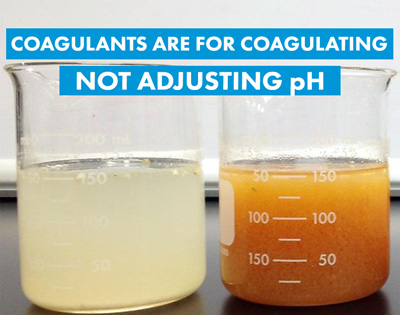If you’re using chemical coagulants to adjust pH, then you’re doing something wrong. You see, if coagulants are meant to be used for adjusting pH, then why do we call them coagulants and not pH reagents? Why add the iron or aluminum salts to the mix? Doesn’t it make much more sense to use an acid (i.e. sulfuric acid) or base solution (sodium hydroxide) to adjust pH? Despite the seemingly obvious nature of the issue, too many wastewater treatment plants unwittingly employ chemical coagulants to adjust pH.
The Purpose of Coagulants is to Coagulate
It sounds simple, but the concept is lost on wastewater operators and environmental engineers alike – coagulants coagulate solids. Everything else is just a side effect.
While alum and ferric-based coagulants are acidic in nature and produce a drop in pH when added to wastewater, their main purpose is to neutralize electrical charges of fine particles in water and clump them together. The best way to determine coagulant dosing is by performing a jar test. When solids are all tied up in pin flocs and water appears clear, then you know you’ve got you’re coagulant dosing dialed in correctly.
So when does this “using coagulant to adjust pH” problem occur?
It Happens All the Time
Aluminum and ferric-based coagulants operate most effectively within a specified pH range (alum: 5.5-7.5; ferric: 5.0-8.5). Wastewater with higher pH values might require pH neutralization before being sent through wastewater process equipment. The correct approach for this situation would be to use an acid (sulfuric acid, hydrochloric acid) to drop the pH. Far too often what happens is that coagulant is dumped into the wastewater to adjust pH to neutral range. That’s simply not a smart thing to do.
The Unintended Effects
There are plenty of reasons not to use coagulants for pH adjustment. Here are just a few of them.
- Coagulants are expensive – you can go through totes of coagulant to achieve the pH adjustment attainable with a single drum of sulfuric acid. The right tool for the job makes things much easier.
- Coagulants generate sludge – they’re metal-based. That means the metals actually add to the volume of solids removed from the wastewater. That means more sludge to store, dewater, and dispose of.
- Unconsumed coagulants contribute to COD – when there aren’t enough solids for the coagulants to react with, the metal atoms begin reacting with water molecules and dissolve into solution. If you’ve got a secondary treatment process, extra COD could really mess things up.
The key lesson here is that coagulant dosing is directly related to water clarity. If water appears murky after treatment, the operator could probably stand to add a little more coagulant. The general axiom remains, use the least amount of coagulant necessary to achieve the required water clarity. If pH sits a little high on the scale, use acid to bring it within the neutral range and then hit it with the coagulant, you’ll find that the wastewater treatment process becomes much more stable.
For those all-too-familiar with some of the things discussed here, FRC can help build a system to automatically adjust pH with the right chemicals. Contact us and we’ll show you how.

